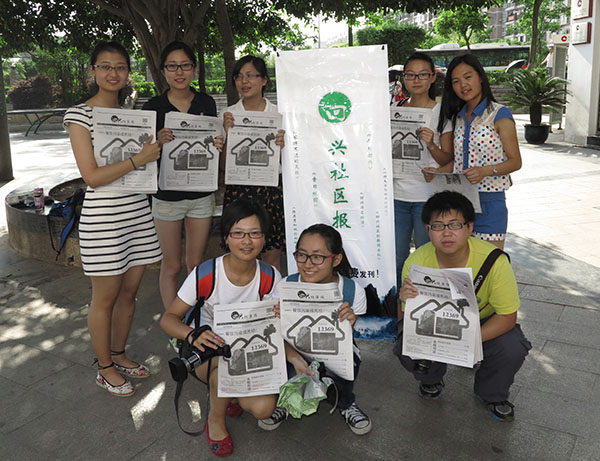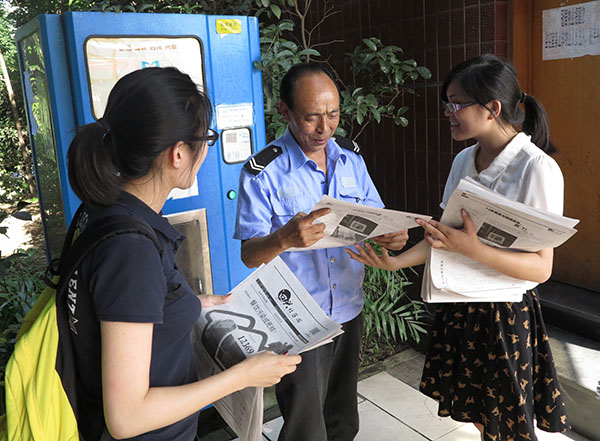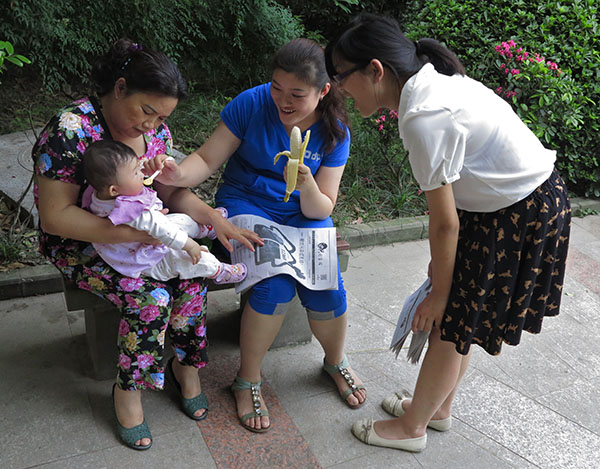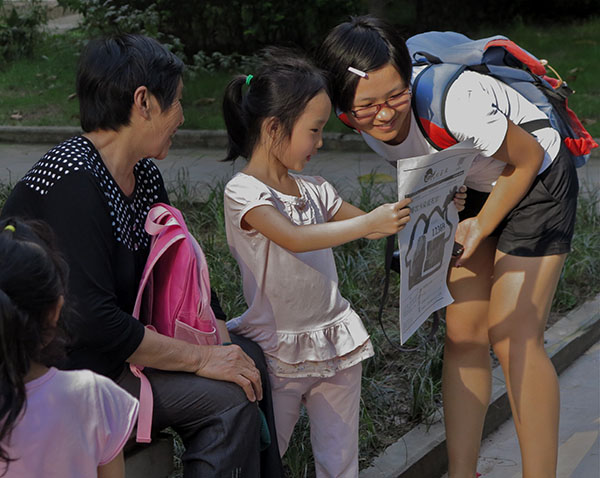Our intrepid traveler is two weeks into a month of lecturing about Community Journalism at conferences, newspaper workshops and universities in Shanghai, Chongqing, Hefei and Zhengzhou, China. This follows last summer’s Fulbright to Beijing, where he taught Community Journalism at three universities, and where at one workshop, he was introduced as “Mr. Joke.” Herein follows Mr. Joke’s reprise.

Newspaper delivery day! Ah, this is where the rubber meets the road. And as an old newsboy, the phrase still stirs me to my roots.
Today I accompany Prof. Li’s students as they hand-deliver the new (fourth) edition of their community newspaper.
The Huixing Journal gets its name from the neighborhood surrounding their university, a collection of high-rise apartment complexes, busy public squares and wide inviting sidewalks facing open-fronted shops catering to the mix of residents, faculty and students. So in a sense, it has the vibe of Franklin Street, Chapel Hill’s main college drag.
Meeting in the main square, the students erect a banner proclaiming the name of the paper, and then set out on their routes by foot. However, when we get to the gate of the main apartment complex, the students must first chat-up the suspicious guard, which Dong (“Betty”) does with great charm and skill. And just like that, we are in!

Once in the wooded gardens that line the path between the apartment towers, I watch with admiration as the students approach each resident, hand him or her a copy of the newspaper and engage them in a personal conversation. No hit-and-run delivery this!
There’s Karlla handing a paper to a young mother, explaining what the paper is, who the students are, why they are doing the paper, and also that it is FREE. This is important because many residents, I’m told, are wary of a scam.
While some residents wave the students off, most are receptive, even to the point of stopping what they are doing and reading the paper right then and there.
I am totally impressed with this one-on-one, journalist-to-reader style of newspaper distribution. It strikes me as so personal and intimate that I can’t help thinking – hey, we ought to adopt this practice with the VOICE in Durham!
Later, another guard stops our little delivery crew, but again Betty schmoozes him into submission, and off we go again. She is fearless! No doubt a great career awaits this woman.

SERVING A DUAL PURPOSE
Like the Carrboro Commons and the Durham VOICE, the Huixing Journal has a dual purpose — of not only informing and entertaining a neighborhood largely underserved by the existing media — but also of serving as a teaching and learning tool.
The newspapers Prof. Li and I produce are both putting Ernest Boyer’s “theory into practice” by getting the students out of the classroom and into the streets.
Out here, in the real world, real decisions have real consequences— and that’s when students learn effectively.
Both of us, 9,000 miles apart, face myriad challenges. And my problems are miniscule, me thinks, compared to those confronting Prof. Li and his courageous kids. In a country with a state-run media system, a newspaper without a government number (read: license) is basically an outlaw, illegal practice, and subject to severe punishment.
However, the Huixing Journal flies under the radar as “class material.” And since it carries no advertisements, it is not considered a “real” newspaper.
This is precisely the case with our Carrboro Commons and Durham VOICE too, neither of which carry ads and can’t be called “real” newspapers. It’s understood: these are “lab newspapers,” produced by university students under faculty supervision as a teaching device designed to make journalism education come alive and be more relevant.
All the same, the results of a lab paper can be the same. And an erroneous or controversial story in a lab paper can have the same impact as an erroneous or controversial story in a so-called “real” newspaper.
We call such speedbumps, “teachable moments.”
And with this edition of the Huixing Journal, just such a “moment” occurred!
The lead story about street pollution (smoke and grease) created by the neighborhood’s pop-up sidewalk cooking stalls got some push-back when an angry shop-owner phoned Prof. Li, accusing the paper of getting the interview with him under false pretenses.
The reporter who interviewed him did not identify herself as a newspaper reporter, he objected. He said he thought he was just speaking with a random student about the issue of local pollution, and that he wasn’t told that he could be quoted directly in the press.
Ouch!
Prof Li, who fielded the phone call, promised quick action. And the very next day, he and the student-reporter went in person to apologize to the shop-owner, who was so impressed that he invited them to do a follow-up interview with him about his attempts to improve the pollution situation.
Problem solved, lesson learned and local news source satisfied.

WHAT ARE WE DOING HERE?
One of Prof. Li’s students, Wang Jingyi, who calls herself “Jeannie,” explained to me why the Huixing Journal, in spite of its obstacles, is so valuable.
“What we’re doing (may be) Mission Impossible,” she told me, “because the Huixing Journal wants to be a glue that connects people together…because people here have a weak sense of community, we want to devote our efforts to helping them feel together. This goal is our mission of launching the Huixing Journal.”
Way to go, kids.

